
drawing, print, etching, ink
#
drawing
#
ink drawing
#
pen drawing
# print
#
etching
#
ink
#
cityscape
Dimensions: 21 7/8 x 16 1/2 in. (55.56 x 41.91 cm) (image)24 1/4 x 18 7/8 in. (61.6 x 47.94 cm) (sheet)
Copyright: No Copyright - United States
Curator: Let's examine Joseph Pennell's 1912 etching, "The End of the Day," currently held at the Minneapolis Institute of Art. The work predominantly employs ink on paper, showcasing a dense industrial cityscape. Editor: It immediately strikes me as bleak. There's a palpable sense of oppression evoked through the composition. The imposing verticality of the dock dwarfs the human figures. Curator: Notice how Pennell manipulates light and shadow. The stark contrasts, achieved through cross-hatching and varying line weights, create a dynamic visual texture. Consider, too, the composition; the vertical orientation emphasizing the depth of the dry dock against a turbulent sky. Editor: Indeed, and it's crucial to see this image as a commentary on labor, particularly in the early 20th century. These are not abstract forms; these are working-class bodies suspended precariously by a crane at day’s end. They are essentially commodities themselves, being moved. It speaks volumes about the dehumanization inherent in industrial capitalism. Curator: You introduce a valid point regarding the symbolism present. While the formal arrangement commands attention through its spatial rendering, we shouldn't ignore that Pennell was known to depict sites of tremendous construction— Panama Canal, for example, that showcase feats of engineering, in line with the style of the picturesque, and that also served propagandistic ends. Editor: I would press harder on the question of what is being propogated in this view; the cost to working-class bodies, extracted labor and danger. This piece evokes Millet’s “The Gleaners” but turned on its head, inverted, and imbued with dread rather than bucolic harmony. The "danger keep out" sign feels like the only sincere signifier of what to find here: precarity. Curator: I find your comparison thought-provoking. His strategic application of darkness creates visual tension that's key to comprehending its deeper content. Editor: Analyzing Pennell’s print offers a compelling intersection to analyze class struggle embedded within turn-of-the-century American art. Curator: A precise and fitting way to put this into a contemporary lens; I hadn't thought of the figures as such. Thanks!
Comments
minneapolisinstituteofart almost 2 years ago
⋮
Joseph Pennell prided himself on immortalizing the world's great industrial behemoths, but he believed his life would not be complete unless he could chronicle the greatest wonder of them all—the building of the Panama Canal. Photographs show him wandering the site in his tweeds, campstool in hand. He chanced to capture this amazing scene at quitting time, as the workers were being hauled, clinging to a chain, out of eighty-five-foot-deep Gatun Lock. "No one could imagine it—and I had only a minute to see it," Pennell wrote. He sketched such scenes on special coated transfer paper and executed the prints on lithographic stones back home in Philadelphia.
Join the conversation
Join millions of artists and users on Artera today and experience the ultimate creative platform.














